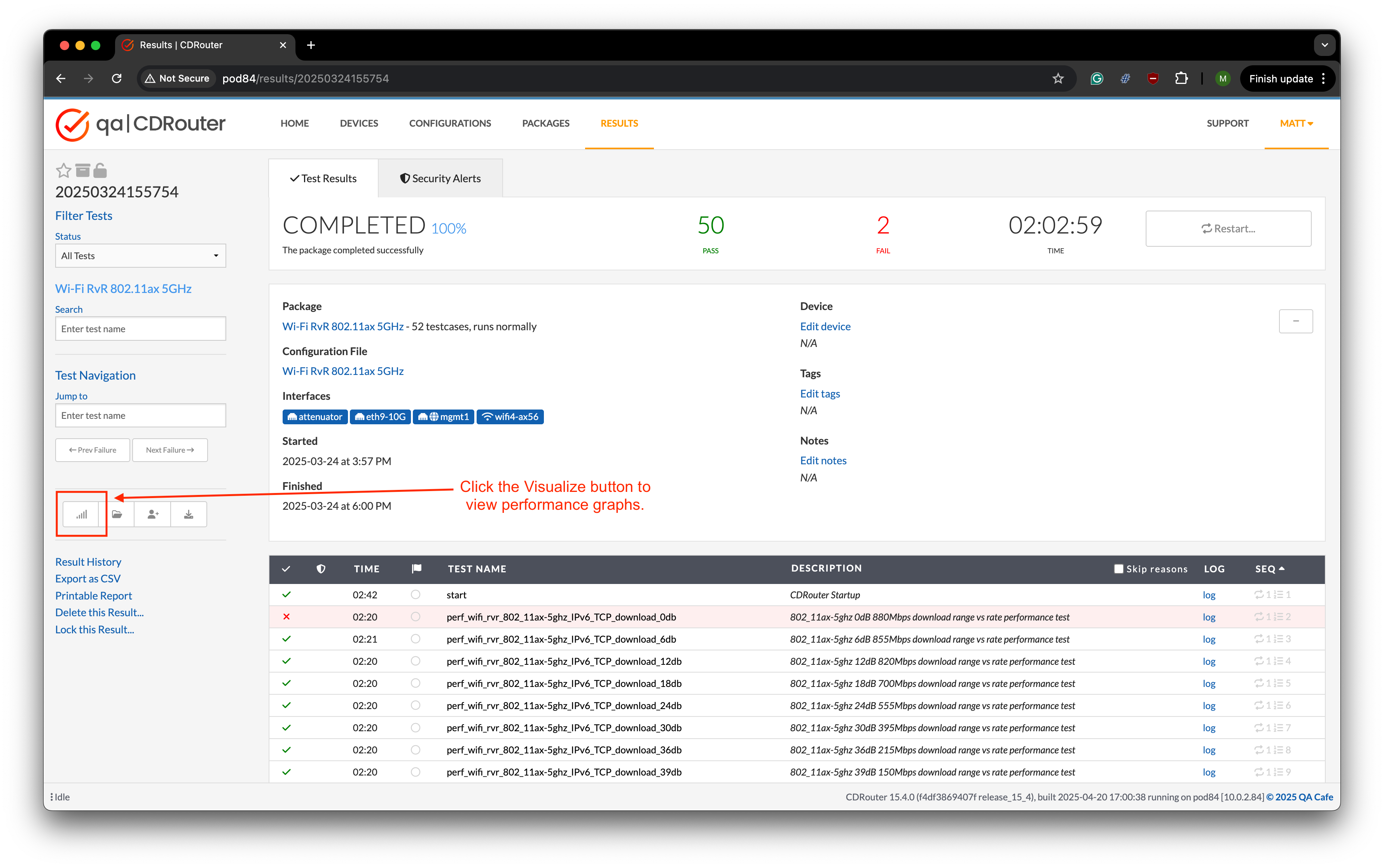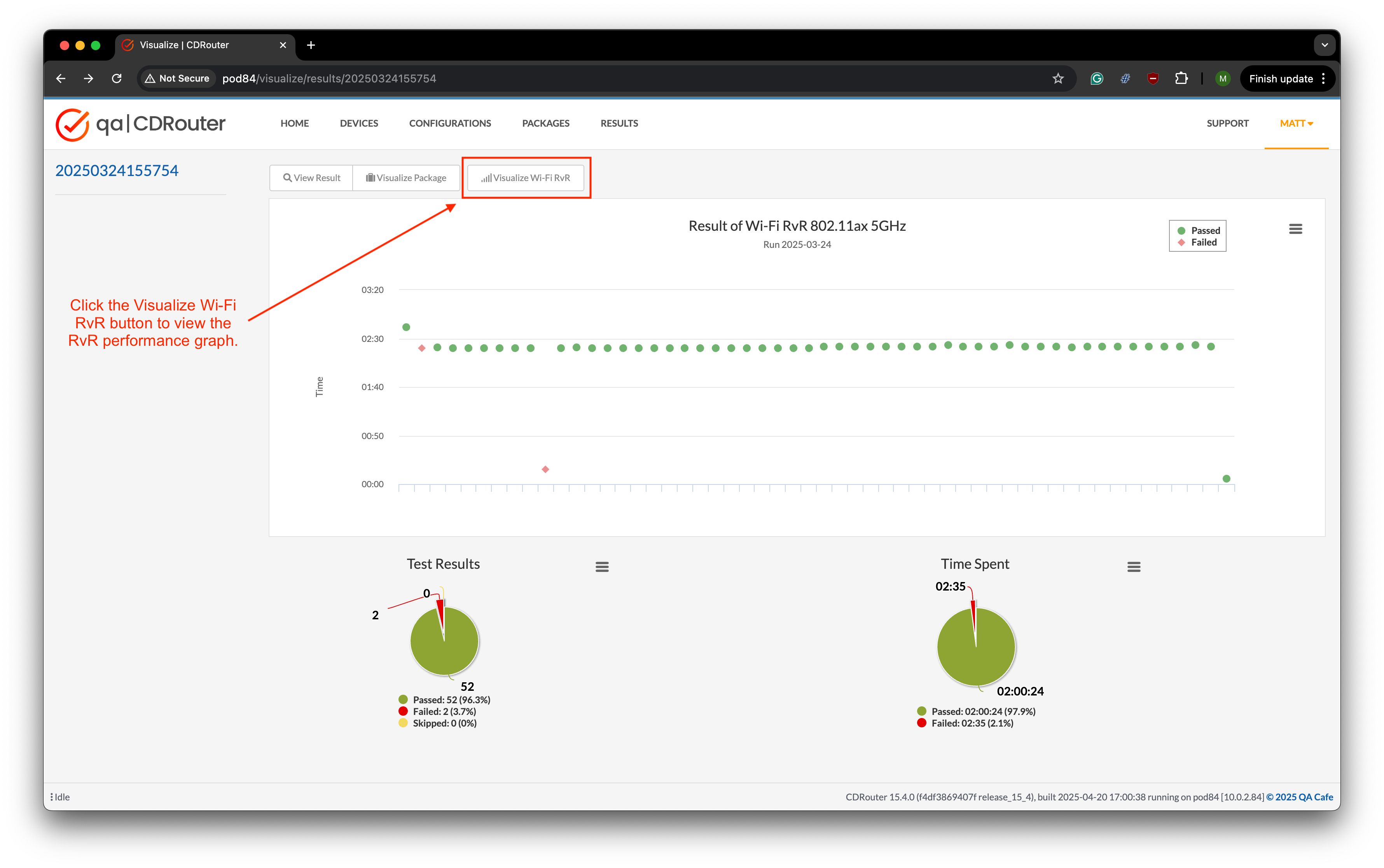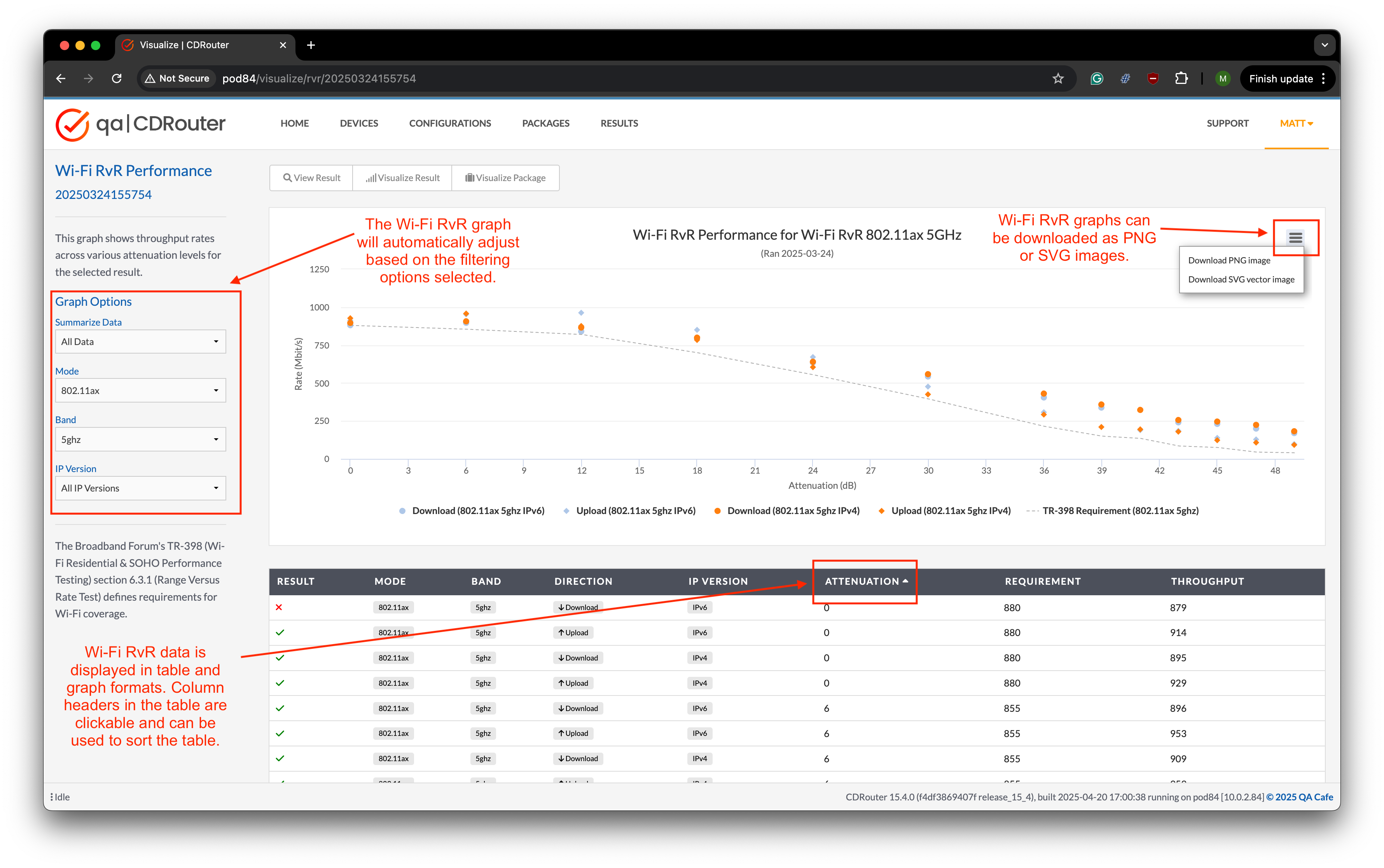CDRouter Wi-Fi Range vs Rate (RvR) User Guide
Overview
The Wi-Fi Range vs Rate (RvR) expansion for CDRouter enables wireless range versus rate performance testing using a programmable RF attenuator to simulate varying signal conditions. The tests in this expansion follow the general principles, procedures, and test scenarios defined in Section 6.3.1 of the Broadband Forum’s TR-398 test specification.
This expansion consists of both software and hardware components. For details on licensing and hardware requirements, please contact sales@qacafe.com.
Key Features
- Comprehensive Testing – Implements Range vs Rate testing across multiple bands and Wi-Fi modes.
- Minimal Configuration – Designed for ease of use with straightforward setup and test execution.
- Fully Automated – Seamless integration with CDRouter enables hands-free test execution.
- Integrated RF Attenuation – Natively supports the Adaura Technologies 8-channel programmable RF attenuator for precise control over signal conditions.
- Turn-Key Solution – Includes all necessary cabling and accessories for a complete out-of-the-box testing experience.
- Pass/Fail Criteria – Evaluates performance using TR-398 metrics, and allows modified throughput thresholds according to your requirements.
- Part of the CDRouter Suite – Extends CDRouter’s capabilities with fully integrated Wi-Fi performance testing.
- Adds attenuation to any Test - Adds new dimension to CDRouter with ability to configure a set attenuation for the entire package run - not just RvR.
Wi-Fi RvR Performance Graphs
Wi-Fi RvR specific graphs have also been added to the Visualize tool. To view RvR performance graphs, click the Visualize button from a test result:

Next, click the Visualize Wi-Fi RvR button:

This opens the Wi-Fi RvR graph, which displays the measured performance against the minimum performance metrics defined in TR-398. You can filter RvR data using the graph options in the left sidebar. Graphs can also be downloaded in SVG or PNG format for easy inclusion in reports or other tools.

Connections
For detailed information on the connections, please refer to the Wi-Fi RF Attenuator Kit (RAK) documentation.
Device Under Test (DUT) Configuration
The recommended DUT configuration for RvR testing is defined in Section 5.3 of the Broadband Forum’s TR-398 specification. Please review this section to ensure correct setup of the DUT for optimal test performance.
Available Test Modules
The CDRouter Wi-Fi RvR Expansion includes a variety of test modules covering 802.11 modes (n, ac, ax, be) and multiple frequency bands (2.4GHz, 5GHz, 6GHz) with support for both IPv4 and IPv6.
- 802.11n (2.4 GHz only)
- IPv4: fixed-wifi-rvr-perf-802_11n-2_4ghz.tcl
- IPv6: fixed-wifi-rvr-perf-802_11n-2_4ghz-v6.tcl
- 802.11ac (5 GHz only)
- IPv4: fixed-wifi-rvr-perf-802_11ac-5ghz.tcl
- IPv6: fixed-wifi-rvr-perf-802_11ac-5ghz-v6.tcl
- 802.11ax
- IPv4: fixed-wifi-rvr-perf-802_11ax-2_4ghz.tcl
- IPv4: fixed-wifi-rvr-perf-802_11ax-5ghz.tcl
- IPv4: fixed-wifi-rvr-perf-802_11ax-6ghz.tcl
- IPv6: fixed-wifi-rvr-perf-802_11ax-2_4ghz-v6.tcl
- IPv6: fixed-wifi-rvr-perf-802_11ax-5ghz-v6.tcl
- IPv6: fixed-wifi-rvr-perf-802_11ax-6ghz-v6.tcl
- 802.11be
- IPv4: fixed-wifi-rvr-perf-802_11be-2_4ghz.tcl
- IPv4: fixed-wifi-rvr-perf-802_11be-5ghz.tcl
- IPv4: fixed-wifi-rvr-perf-802_11be-6ghz.tcl
- IPv6: fixed-wifi-rvr-perf-802_11be-2_4ghz-v6.tcl
- IPv6: fixed-wifi-rvr-perf-802_11be-5ghz-v6.tcl
- IPv6: fixed-wifi-rvr-perf-802_11be-6ghz-v6.tcl
CDRouter Base Configuration
To run RvR tests, a suitable CDRouter wireless LAN interface must be selected to match the test requirements. Below are the interfaces that may be used based on the test case:
Interface Selection for Test Cases
- 2.4GHz
- 802.11n or 802.11ax: wifi1-ax24, wifi3-ax24, wifi5-ax24, wifi7-be
- 5GHz
- 802.11ac or 802.11ax: wifi2-ax56, wifi4-ax56, wifi7-be
- 6GHz
- 802.11ax: wifi6-ax56, wifi7-be
- 802.11be
- wifi7-be
Configuring Wireless LAN Interfaces in CDRouter
For guidance on configuring wireless interfaces in CDRouter, refer to the following resources:
- How do I configure CDRouter to use a wireless LAN interface?
- Wi-Fi Troubleshooting Guide
- Configuring Wireless LAN Interfaces in CDRouter (video)
Test Execution Behavior
- CDRouter will skip tests that are unsupported based on the selected interface or station configuration.
- When a station is associated with a single band, tests that require other bands will be skipped.
- CDRouter will attempt to reassociate using the necessary PHY mode prior to running a test. If reassociation fails, the test will fail.
- If the station does not meet the following prescribed channel widths for a
given PHY mode and band, the test will fail:
- 802.11n (NSS=2): 20 MHz
- 802.11ac (NSS=2): 80 MHz
- 802.11ax, be (2.4 GHz, NSS=2): 20 MHz
- 802.11ax, be (5 GHz, NSS=2): 80 MHz
- 802.11ax (6 GHz, NSS=2): 160 MHz
- 802.11be (6 GHz, NSS=2): 320 MHz
- Note: The channel width check can be disabled using the testvar
rvrTr398StrictMode. The number of spatial streams (NSS) is not checked. Thresholds for 802.11ax are applied to 802.11be as the Broadband Forum has not yet published specific thresholds for 802.11be.
Attenuator Configuration
The RvR tests require minimal configuration of the Adaura Technologies programmable RF attenuator. New Wi-Fi RvR specific testvars have been added to the CDRouter Wi-Fi Range vs Rate (RvR) Expansion section in the config file.
CDRouter Wi-Fi Range vs Rate (RvR) and RF Attenuator Configuration
To enable the RF attenuator and RvR testing, set the testvars supportsAttenuator
and supportsPerformance to “yes”:
testvar supportsAttenuator yes
testvar supportsPerformance yes
Optionally, the pass/fail thresholds can be adjusted up or down using the
testvar rvrThresholdPct.
Expanded Package Run Attenuation Control
Starting with the 15.9 Release, CDRouter has the option to set the attenuation for all tests in a package, not just RvR.
To set an attenuation value for CDRouter to use for all tests in the package,
set the testvar rfAttenuationDb to the desired value, and
enable the attenuator. Performance may also be enabled to run any tests in the
CDRouter performance modules with attenuation.
testvar supportsAttenuator yes
testvar rfAttenuationDb 10.05
# optional
testvar supportsPerformance yes
No other configuration is required. CDRouter will configure the attenuation at the start of a package, and reset it when completed. If the test package included any RvR tests, those tests will use the attenuation value given in the test, and CDRouter will restore the user attenuation when the test completes.
Note: The RF Attenuation value configured must be a non-negative multiple of 0.05, less than 100.0.
CDRouter Performance Configuration
The RvR tests are considered fixed (immutable), and as a result, the typical performance parameters in CDRouter are not used. Instead, the following parameters are applied as per TR-398:
- Bandwidth: Maximum
- TCP Payload Size: Auto
- Streams: 8
- Duration: 120 seconds
- Threshold: See Section 6.3.1 in TR-398
Wi-Fi Isolation Chambers for Optimal Testing
For optimal RvR testing, it is highly recommended to use a Wi-Fi isolation chamber to eliminate external interference and ensure a controlled test environment. These chambers allow you to isolate the DUT(Device Under Test) and wireless network from other devices, networks, and environmental factors that could affect test accuracy and reliability.
Chamber Recommendations
While the RvR expansion does not include a Wi-Fi isolation chamber, many companies sell these specialized testing enclosures. We use and recommend the Model 2424 isolation chambers from JRE Test. These chambers provide excellent isolation and performance for Wi-Fi testing, and we have several units in our lab to conduct a wide range of wireless tests.
The Model 2424 units feature:
-
Fully shielded enclosure for minimal RF leakage
-
Ample space for DUTs and antennas
-
Multiple RF feedthroughs to connect devices inside the chamber
-
Precise control of environmental factors to ensure consistent testing
For more information on the Model 2424 or to inquire about purchasing a chamber, please visit the JRE Test website.
Additional Resources
For further details, refer to the following resources: